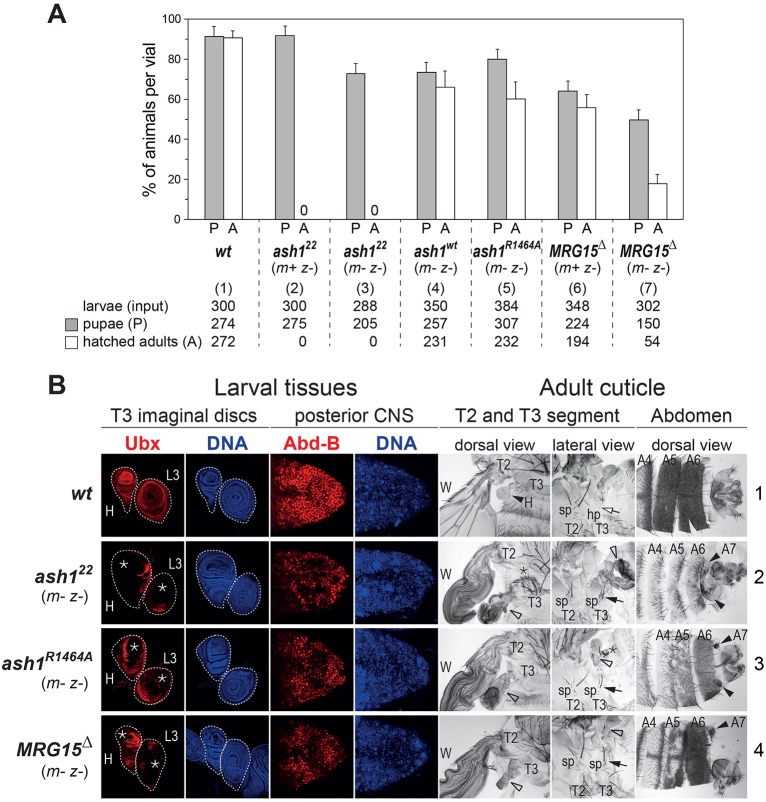Fig. 4.
Requirement of AMC HMTase activity for viability and HOX gene regulation. (A) Viability of Drosophila with different ash1 and MRG15 mutant genotypes. For each genotype [(1)-(7)], indicated numbers of 1st/2nd instar larvae (input) were isolated, distributed into at least three different food vials and reared. In each vial, the percentage of animals that formed pupae (grey bar) and eclosed from the pupal case (white bar) was determined. Histograms represent the mean±s.d. of these percentages in individual vials of a given genotype. ash122 m+ z− and ash122 m− z− animals do not eclose from the pupal case (asterisk). The genotype of MRG15Δm+ z− and MRG15Δm− z− animals shown here and in B is MRG15Δ/Df(3R)BSC741 (see text). (B) Lack of AMC function causes a specific HOX loss-of-function syndrome. Left: HOX gene expression analysis. Larval haltere (H) and third leg (L3) imaginal disc tissues stained using Ubx antibody (red) and co-stained with Hoechst to visualize nuclei (DNA, blue); CNS tissues stained using Abd-B antibody (red) and Hoechst (DNA, blue). In the wild type (wt), Ubx is expressed in all cells of the H and L3 disc. ash122 m– z–, ash1R1464A m– z– and MRG15Δm– z– mutants show patchy loss of Ubx expression (asterisks) in irregular patterns in both discs; this phenotype is observed in all animals in all three genotypes (n>40) but comparison of discs from these larvae shows that the tissue area showing loss of expression is most extensive in ash122 m– z– mutants, somewhat less extensive in ash1R1464A m– z– mutants and even less extensive in MRG15Δm– z– mutants. In wild-type animals, Abd-B is expressed in all cells of the posterior CNS, whereas ash122 m– z–, ash1R1464A m– z– and MRG15Δm– z– mutants all show patchy loss or reduction of Abd-B expression. Right: cuticle phenotype analysis. Preparations of cuticles from adults (row 1) or pharate adults (row 2-4) with dorsal and lateral views of T2 and T3 segment structures and dorsal views of the posterior abdomen, including the A4, A5 and A6 segments. Dorsal view T2 and T3: in wild-type animals, haltere disc tissues form the haltere (H, black arrowhead) in T3. ash122 m– z–, ash1R1464A m– z– and MRG15Δm– z– mutants show haltere-to-wing transformations (empty arrowheads; wing in T2 marked as W in all cases), owing to loss of Ubx expression. The extent of this T3 to T2 transformation matches the extent of Ubx expression loss in the three mutant genotypes (ash122 m– z–>ash1R1464A m– z–>MRG15Δm– z–). Lateral view T2 and T3: T3 to T2 transformation in ash122 m– z–, ash1R1464A m– z– and MRG15Δm– z– mutants due to loss of Ubx expression in the 3L disc is manifested by transformation of the hypopleurite (hp) in T3 (empty arrow in wild-type animals) into sternopleurite (sp) tissue with sp bristles (black arrows), which are normally only found in T2. The haltere-to-wing (empty arrowhead) and meta- to mesonotum transformations (asterisk) are variable in animals of the same genotype (compare lateral and dorsal views). Dorsal view of abdomen: wild-type males show characteristic pigmentation in A5 and A6 that is almost completely lost in ash122 m– z– mutants or lost in a patchy pattern in ash1R1464A m– z– and MRG15Δm– z– mutants. A7 segment structures appearing in the three mutant genotypes are indicated.

